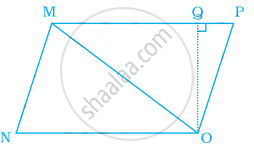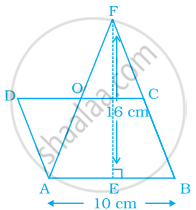Advertisements
Advertisements
प्रश्न
If the sides of a parallelogram are increased to twice its original lengths, how much will the perimeter of the new parallelogram?
पर्याय
1.5 times
2 times
3 times
4 times
उत्तर
2 times
Explanation:
Let the length and breadth of the parallelogram be l and b, respectively.
Then, perimeter = 2(1 + b) ......[∵ Perimeter of parallelogram = 2 × (length + breadth)]
If both sides are increased twice, then new length and breadth will be 21 and 2b, respectively.
Now, new perimeter = 2(21 + 2b) = 2 × 2(l + b) = 2 times of original perimeter.
Hence, the perimeter of parallelogram will be increased 2 times.
APPEARS IN
संबंधित प्रश्न
The area of parallelogram whose base 10 m and height 7 m is
The base of the parallelogram with area is 52 sq.cm and height 4 cm is
If the base and height of a parallelogram are in the ratio 7 : 3 and the height is 45 cm, then fixed the area of the parallelogram
Ratio of area of ∆MNO to the area of parallelogram MNOP in the same figure is ______.

To find area, any side of a parallelogram can be chosen as ______ of the parallelogram.
Perpendicular dropped on the base of a parallelogram from the opposite vertex is known as the corresponding ______ of the base.
In the given figure, area of ∆AFB is equal to the area of parallelogram ABCD. If altitude EF is 16 cm long, find the altitude of the parallelogram to the base AB of length 10 cm. What is the area of ∆DAO, where O is the midpoint of DC?

In the given figure, find the area of parallelogram ABCD, if the area of shaded triangle is 9 cm2.

Altitudes MN and MO of parallelogram MGHK are 8 cm and 4 cm long respectively in the below figure. One side GH is 6 cm long. Find the perimeter of MGHK.

ABCD is a parallelogram in which AE is perpendicular to CD as shown in the given figure. Also, AC = 5 cm, DE = 4 cm and area of ΔAED = 6 cm2. Find the perimeter and area of parallelogram ABCD.
